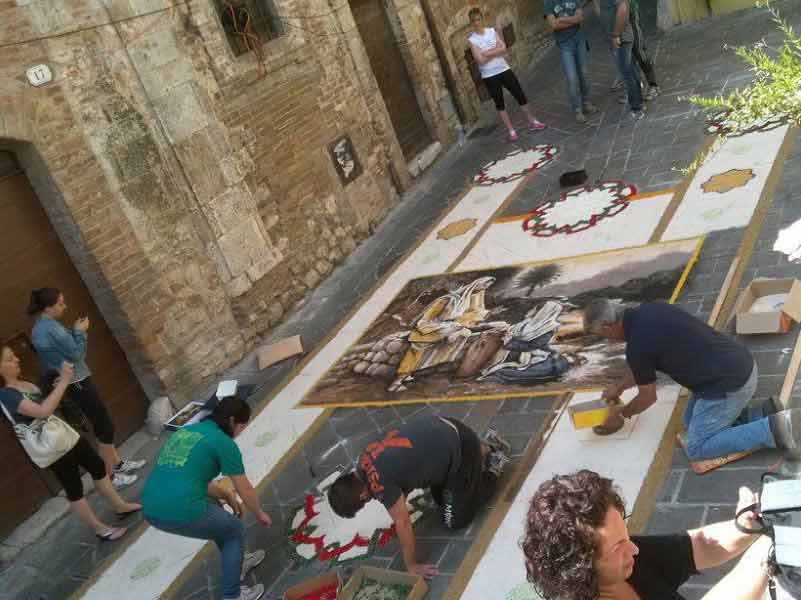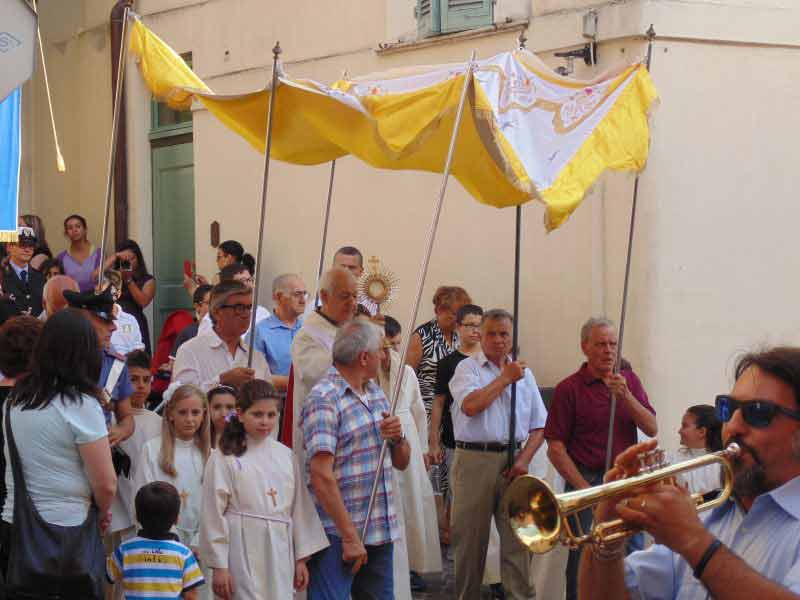
By Kerry Rose Graning
Travel Writer22 Feb 2019 - 6 Minute Read
Here it was – the Catholic guilt. My fear of judgment, which had lain dormant for years since my schoolgirl days, now rose in my throat as I waited for the priest to exit the Church of Santo Gemine and smile down at the flower mosaic of a dove I had helped create at his feet. But as the doors opened, he instead swung one foot out from under his robe and absentmindedly booted the dove’s feathers across the cobblestones.
The Italian crowd cheered. I swore.
The night before, having finished up work on a nearby archaeological excavation, I had been wandering the streets of San Gemini, a medieval-era town north of Rome, when a yellow-permed and rhinestone-bedazzled grandmother hissed, “Veni qui” from a nearby doorway. Pulling me through and sitting me down before a hill of red, yellow, and even green carnations, she presented a white one to me. Before I could take it, she grabbed the petals and rent it off its stem like she was wringing a chicken’s neck. She smiled encouragingly, her sewing scissors quickly chewing the flower into bite-size pieces collecting in a shoebox at her feet.
I would not realize until much later that I had been dragged into one of the Infiorata flower-art festivals which are held across Italy throughout May and June. It was lost in translation as she spoke Italian to me and I responded in English. For three hours, we snipped as other nonnas swarmed through the room. She’d say something about “mio nipote," (her grandson), and they’d all look over at me. One of them, shaking her head, raised her pinky finger. (Too thin?) “Mangia,” she tsked, force-feeding me focaccia and rosemary roasted potatoes.
At midnight, the first nonna stood, pulling me out onto San Gemini’s snaking road. The stone pathway was now hidden under a natural mosaic of flowers, seeds, and coffee grounds, forming a tapestry of sunrises, crosses, and oceans that stretched between the churches at opposite ends of town. She planted me down at one of the designs – a half-completed stained-glass window of Jesus and Mary atop a paper outline like a coloring-book page – and disappeared. Around me, mothers brushed watery glue across paper and instructed their children: giallo fiore here, verde there. Fathers carried over baskets of coffee grounds and sand to sprinkle between the flowers. Old men criticized technique from the sidelines.

A young woman with a buzzcut grabbed my cheeks and, rubbing her finger across my chin and lips, nodded, “Bella.” But before I could blush, she held a mirror up to my new charcoal goatee and said, “Now do me!”
Once adorned, she handed me a cup of glue and boxes of carnations and sand to spread across a paint-by-numbers-style outline. As I contoured Mary’s cheekbones, she told me in broken English about the first Italian flower carpets, which can be traced back to Benedetto Drei, the florist who decorated the Vatican on the Feast Day of St. Peter and Paul in 1625. Today, she said, the Infiorata festivals are usually held nine weeks after Easter in celebration of Corpus Domini, the transformation of the bread and wine into the body and blood of Christ. Local families, friend groups, and even high school classes plan and sketch out their individual designs for months. When asked about rules for design choices and placement, she didn’t have a concrete answer, as if the town no longer needed a rulebook for something so engrained.
Hours later, with the sun barely breaking over the high stone walls, the nonna returned and the three of us sat at a nearby café, where I threw back espresso shots and napped while she yelled at the street sweeper who’d gotten too close to a crucifix of sand. The hours crept by, the day-trippers multiplied, and the espresso had turned to vino when a man in denim loafers and a mesh PRIDE tank top broke through the crowd. “Mio nipote!” the nonna shouted, winking at me with a matchmaker’s satisfaction as her (clearly uninterested) grandson shrugged and rolled his eyes.
Finally, at five p.m., the church bells clanged and the Catholic guilt rose and the priest strode the length of the tapestry, destroying it more with each step. I turned to the nonna, indignant, ready to translate her Italian curse, but instead found her crying softly. “Isn’t it lovely?” the mustached woman – who had neglected to tell me this would happen – called out, as everyone followed the priest up the central road and through every design on the way to the other church. The crowd swept us up, and we were lost to it and to each other.

In the upcoming days, I would ask Italians on trains and in bars about the Infiorata festival. Some would speak of the flowers themselves, signs of Christ’s rebirth. To my surprise, many would shrug lightly when I asked about their destruction, as if perplexed that I thought these delicate displays should last forever. One woman would say that in her hometown, it’s the children allowed to play on the designs who destroy them, not the priest – as if one manifestation of joy was giving way to another.
But all agreed that I could still cherish the experience I had, even if I had to let it go – a concept I wasn’t yet able to put into words myself that night, as I walked back to my hotel and came upon one last floral image, a coffee-grounds goblet filled with red carnations. But shrugging and laughing lightly, I clipped it with my foot anyway, spilling the wine into the street.
Discover similar stories in
connection
Travel Writer
Kerry is a committed freelance writer and archaeologist. When she isn’t following modern-day moonshiners on writing assignments or digging up ancient trash, she likes to bring the living along on cemetery tours.




No Comments